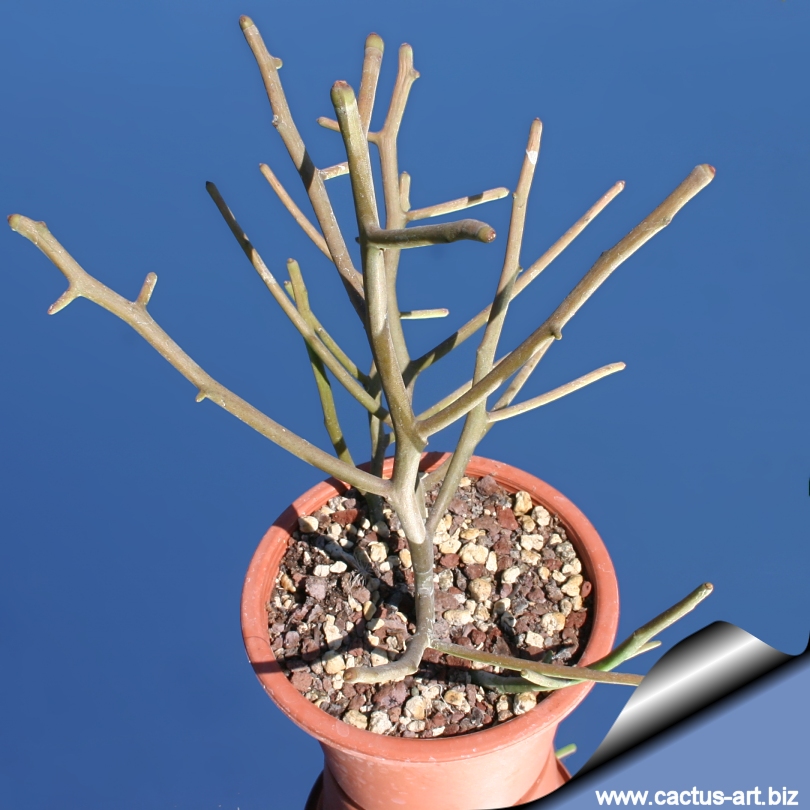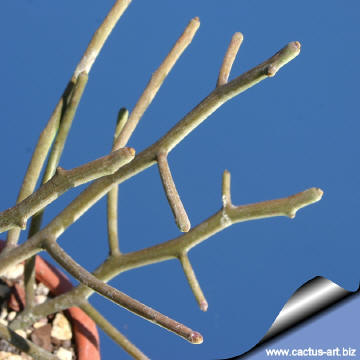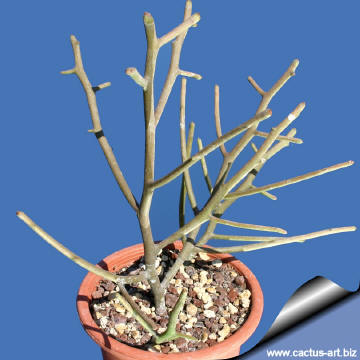|
|
|

Euphorbia intisy var. mainty
Spineless beautiful, much-divided slim pencil
branches creating a compact woody thicket. With time, can achieve
considerable dimensions.
|
 |
 |
Warning: All parts of
Euphorbia intisy ooze a milky sap when damaged or cut. Contact with this
sap may cause dermatitis in some people, and in the eyes the sap can
cause temporary blindness which may last for several days.
|
|


Advertising
|
|
|
|
|
Family: Euphorbiaceae
Accepted
scientific name: Euphorbia intisy
var. mainty Poiss. 1912.
Common English Names include:
Pencil Plant,
Pencil Cactus, Rubber Hedge Euphorbia.
Origin: Madagascar (Sud, environs de Fort-Dauphin)
Habitat: Spiny forest on arid regions,
where it is almost extinct due to over-exploitation for rubber
collection.
Conservation status: Listed in
CITES appendix 2.
Synonyms:
- Euphorbia mainty (Poiss.) Denis
ex Leandri
Catalogue des Plantes de Madagascar, Euphorbiaceae
16. 1935. (Cat. Pl. Madag., Euphorb.)
- Euphorbia intisy Drake
Published In: Recherches sur la Flore Méridionale de
Madagascar 51. 1912. (Rech. Fl. Mérid. Madagascar)
- Tirucallia intisy
|
|
Description: Small leafless
succulent ranging from many-branched shrubs to large trees up to 6 m
tall (but usually less) the brush-like masses are the best known feature
of this species. It is similar to E. tirucally but it will
always maintain more intricate, more intensely intersticed stems and
stemlets.
Stems: Grows with single or multiple trunks which support a
tangle of pencil thick, cylindrical succulent branches, that are smooth
and glabrous dark brownish-green, 5-8 mm in diameter. This plant is
characterized by sympodial growth, that is the terminal bud of each twig
abruptly dies and the growth is continued by lateral buds, season after
season.
Spines: Plants are without spines.
Leaves: The leaves are small and slender, rarely seen, as they
fall very early.
Roots: With small holes where the plant store the water allowing
the intisy tree to survive to severe drought.
Flower: Flowers are axillary in sub-apical position. The true
flowers, which are centred within the bracts, are inconspicuous.
|
|
|
|
Cultivation: It is an easy species to grow that is suited for any
well drained soil in full sun. But young plant are happy growing
indoors, where they can easily reach the ceiling. Give the plant an airy
growing medium which mainly consists of non organic material such us
clay, pumice, lava grit, and only a little peat or leaf-mould. Water
regularly during the active growing season from March to September. No
water should ever be allowed to stand around the roots. Keep almost
completely dry in winter. It is a moderately fast grower, and will
quickly become large landscape masterpieces in just 3-5 years. Only
downside is from strong winds, the columns often smash into each other,
causing permanent scarring... best to plant in such a location where
winds are not a big issue. If plant becomes very red, this is a sign
that the roots have not developed properly. It is a relatively fast
growing and long lived plant and once established, it will be content in
its position and with its soil for years. It can tolerate moderate
shade, and a plant that has been growing in shade should be slowly
hardened off before placing it in full sun as the plant will be severely
scorched if moved too suddenly from shade into sun. Like quite small
pots, repott in very later winter, early spring. Can be pruned for shape
and branching. Frost tender, frost free zones only. Plant Pests:
Prone to mealy bugs and rarely scale.
Propagation: It is
easy to propagate by cuttings in late spring to summer, just take
a cutting of the plant let it dry for 1 and stuff it in the ground
(preferably dry, loose, extremely well draining soil).
USES: The. "intisy" part is
one of the names by which it is known among the natives; This shrub
contains latex that has had considerable use locally. The rubber
(similar to caoutchouc ) coagulates on the surface of the plant in long
elastic strands and is of high grade.
|
|